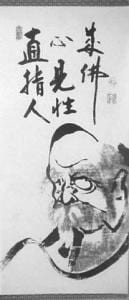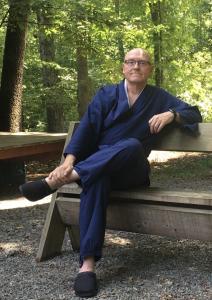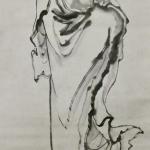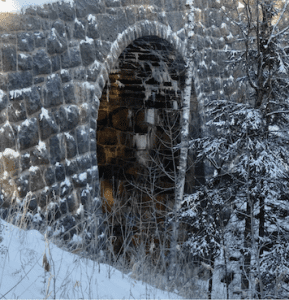Click here to support my Zen teaching practice via Patreon.
Introduction
This post is the third in a series of three on study practice in this lineage of Zen. The first post, The Vital Importance of Studying Buddhadharma: Why and How, was the why and how of study. In the second post, Four Little Fishies in the Big Zen Sea and How They Do Study, I identified some of the study fish in the Zen social media sea (mostly) and fumed about how they miss or misuse dharma study.
For this final offering, I’ll cite some of what the great teachers in our tradition had to say about dharma study, especially Dōgen Zenji and Hakuin Zenji. Essentially, this time, I’ll stand by and letting them do the name calling (mostly).
Stinky Skin Bags
First, then, let’s look at Dōgen Zenji’s teaching from his Shōbōgenzō “Bukkyō” (仏経, “Buddha Sutras”). I encourage you to study with this passage – breath, relax the body (and especially the frontal lobe), center in the belly, take your time (pssst, really there’s nowhere to go), let the passage read you, and return to it tomorrow:
“All types of unreliable, stinky skin bags have said for a couple of hundred years, ‘Don’t keep the phrases of ancestral teachers in mind. Furthermore, don’t carefully read or use the teachings of sutras. Instead, just keep your body and mind like a decayed tree or dead ash. Be like a broken wooden dipper or a barrel with no bottom.’
“Those who speak in this way are a band outside the way or heavenly demons. They seek to rely on what cannot be relied on, and as a result they have idly turned the ancestors’ buddhadharma into a mad and perverse teaching. What a pity! How sad! Even a broken wooden dipper and a barrel with no bottom are ancient sutras of buddha ancestors.” (1)
If you are offended at Dōgen Zenji’s language, let me remind you that for him, “stinky skin bags” is only a moderate rebuke, while something like “dreg slurping dogs” is more of a full-on rebuke. Nevertheless, here Dōgen Zenji wholeheartedly (but moderately) rebukes those who don’t work with key phrases from the ancestral teachers, who don’t study the sutras, and who don’t put the teaching of the sutras to work, but instead uselessly sit on their dead, stinky, skin bag, assholes. Such people, he says, live outside the buddha’s house, reframing the buddhadharma into something “mad and perverse.” Many such stinky skin bags pose as dharma bad asses – it’s the same today as it was in the old Zenji’s time. Pitiful!
Study, by the way, is especially important for converts to the buddhadharma who live in non Buddhist cultures, because without study, such folks as us are more likely to merely rehearse their formations in their practice as if those formations were the true self. Absurd!
Dōgen Zenji emphasizes that such types (i.e., those who don’t take up key phrases from the ancestors, study the sutras, and put the teaching into practice) are unreliable – yes, mad and perverse too, but let’s focus on “unreliable.” Unreliable for what? Pointing to the moon.
However, this bunch do reliably make dharma practice about their own damn selves.
Then in the last sentence in the passage quoted above, “Even a broken wooden dipper and a barrel with no bottom are ancient sutras of buddha ancestors,” Dōgen Zenji characteristically explodes the distinction with his dynamic, nondual vision. Even useless assholes – broken utensils and bottomless conveyances – are exactly the ancient sutras that the buddhas study and teach.
So given that we’ve got plenty of material, we better get to it.
One more observation, though, before I move on to Hakuin Zenji’s teaching: from what I’ve seen in the contemporary dharma scene, often it is precisely those who claim Dōgen’s lineage who best fit his description of unreliable, stinky skin bags. Many today are stuck in the pit of quietism, “silent sitting,” and confuse that dank pit with the abode of the buddhas and ancestors. They wouldn’t know a key phrase from the ancestors if it bit them in their dead asses. Those who don’t study wouldn’t see the moon if it was sitting on their chests (as Ivana Trump once quipped about you know who).
Ain’t that a kicker?!
It is so sad to see the brilliantly luminous teaching of Dōgen Zenji so widely and wantonly misrepresented. Therefore, students and consumers of contemporary Zen teaching, beware!

Parrots and Blind Donkeys
For Hakuin Zenji’s approach to dharma study, let’s look at the last fifth of a verse that he presented at a teaching on the Lotus Sutra in 1746. The entire verse is a powerful summary of the whole Zen path, beginning with these two lines: “Anyone who seeks to master the Buddha Way/Must begin by attaining a kenshō of total clarity.”
“Begin” is the keyword there. But for our purposes, we’ll focus just on the portion of the verse about studying the buddhadharma:
“…I have always lamented Zen [practitioner]’s ignorance of the sutras,
Monks plodding ahead aimlessly like blind donkeys.
Even after kenshō, unless you know Buddha’s words,
You’re like a carriage only fitted out with one wheel.
And if you read the scriptures without having kenshō,
You’re only a parrot imitating someone else’s speech.
I want you to keep the ancients’ practice in mind
While spurring the vow-wheel on to save living beings….” (2)
Hakuin Zenji’s writing is so accessible that it requires less unpacking than old Dōgen’s. Nevertheless, I’ll highlight a few points. Notably, Hakuin makes a distinction between pre-kenshō and post-kenshō practice. He emphasizes the importance of study post-kenshō as a training ground to constantly refine and deepen the initial awakening. This point cannot be emphasized strongly enough.
For pre-kenshō, the old Zenji discourages reading the sutras, presumably because spending one’s time in such a way, rather than wholeheartedly embodying the keyword, is not likely to generate the kind of clear resolve and heat that’s necessary for breakthrough. It’ll likely be about more analytic self involvement while one merely parrots the dharma, using it to reinforce the identity center.
This view of study in the pre-kensho period is embraced by many past teachers, as well as one of my own late-teachers, Harada Tangen Rōshi, who said,
“Truth is not mere explanation—it’s what is happening always and forever, what is happening right now. For that you have to let go of self-grasping, and let go of the desire to look this way and that way, outside yourself, the desire to arrive at the answers rather than to be the answer. Far better than reading volumes of books is to understand fully just one line, just one single word. Like counting the breath, following the breath, shikantaza, your original face before your parents were born. What is the sound of one hand clapping? Just this, just Mu—the brave will find enlightenment in one instant. Open your palms wide, release your hold. You won’t be satisfied by words, they will always seem foreign, far away, separate. You must receive truth fully, wholly—become it.” (3)
Yet, I’d quibble just a bit with these old masters about study before kenshō, especially as I mentioned above regarding convert Buddhists. Without the basic dharma perspective, especially regarding four seals and the great vows, a person may be taking up a practice completely out of context and covertly misusing it. Instead of being disrupted by the buddhadharma such that one receives the “…truth fully, wholly—become it,” such a one might just project their progressive, Western worldview onto their practice, thereby missing the key liberative point.
And although the Rinzai master, Nantenbō Rōshi, was harsh about the uselessness of intellectual understanding, he also valued thorough-going fluency with the buddhadharma. As I mentioned in the last post, for example, he was so concerned about the Rinzai Zen of his time, that in 1893, about a century after the death of Hakuin Zenji’s major disciples, at an assembly of rōshis at Myōshinji, he “…boldly proposed a ruling that would have compelled all recognized rōshi to undertake an examination ascertaining the level of their realization.”
That examination included,
- Hakuin’s eight nantō (difficult to pass through) kōans
- The Record of Linji
- Fenyang’s Ten Wisdoms, Same Truth
- Shoushan’s Verses on the Essential Principle
- The hidden melody of the ten grave precepts
- Composition of verses on the ten grave precepts
- The formless, mind-ground, and substance of the precepts by Bodhidharma
- Xutang’s substitute and alternate phrases (daigo and betsugo) – see The Record of Empty Hall
- Verses on the boundless wind and moon (from The Blue Cliff Record)
- The hidden keys to the five ranks
- The last barrier
- The ultimate conclusion (4)
When Nantenbō Rōshi shared this at Myōshiji and asked for comments, all of the rōshis just sat silently, rejecting the proposal without uttering a word.
To pass an exam like that, well, that would have required true buddhadharma study as I’ve been talking about it here, not the kind of study that merely stuffs up your head with phoney knowledge. It is also notable that although the Zen tradition is often criticized in the West for a lack of emphasis on the precepts, in Nantenbō’s ill-fated exam, at least, three of twelve categories would have required rōshis to express their understanding of the precepts.
The last words on Zen study
As for studying the buddhadharma in our time, I give the last words to Torei Zenji: “For this reason, the practice of the four universal vows first makes liberation of others the number one pledge, along with clarifying your own nature, cutting off the root of afflictions, studying all teachings, and carrying out the activities of bodhisattvas, so compassion and wisdom are completely fulfilled. This is called the way of Buddhas.” (5)
(1) Dogen, Treasury of the True Dharma Eye: Zen Master Dogen’s Shobo Genzo, 53 “Buddha Sutras,” trans. Kaz Tanahashi.
(2) Hakuin Ekaku, The Complete Poison Blossoms from a Thicket of Thorns, #78. Instructions to the Assembly at the Opening of a Lecture Meeting on the Lotus Sutra, trans. Waddell.
(3) Unpublished, but forthcoming from Shambhala in Throw Yourself into the House of Buddha, edited by Kōgen Czarnik.
(4) Michel Mohr, “Monastic Tradition and Lay Practice from the Perspective of Nantenbō: A Response of the Japanese Zen Buddhism to Modernity,” 76-77, modified.
(5) The Undying Lamp of Zen, Torei Enji, trans. Thomas Cleary, 22. Underlining added.














